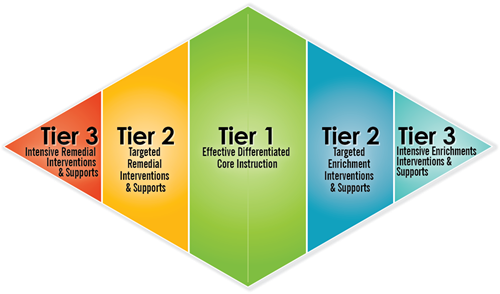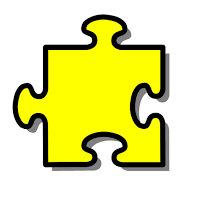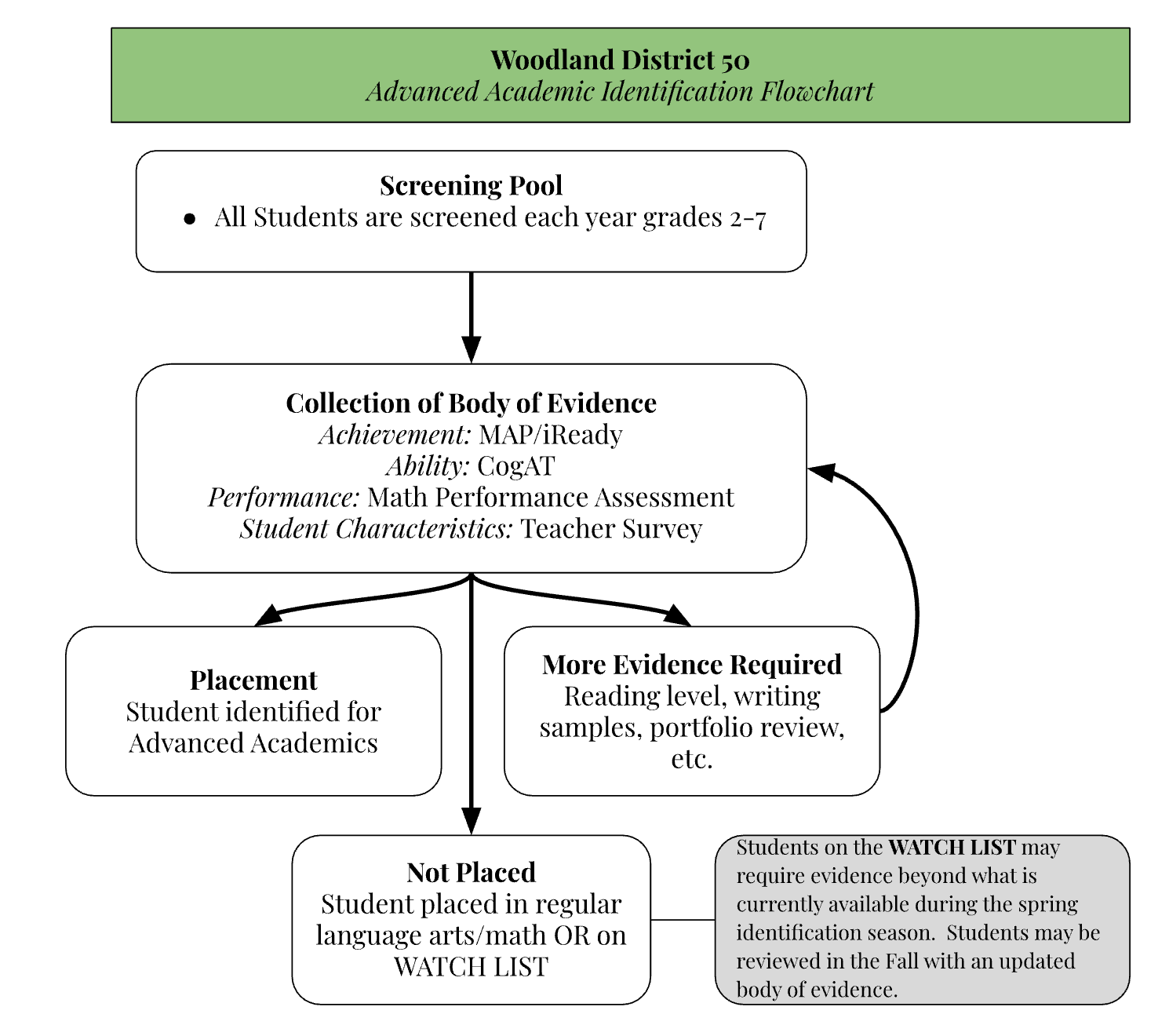Challenge & Advanced Academics
The Department of Teaching and Learning oversees English Language Arts, Spanish Language Arts and Math advanced academic services for students in grades 3 through 8. Advanced Academic services include both Challenge and Advanced classes.
Belief:
We believe Woodland District 50 students can thrive in an environment that provides a continuum of learning to maximize the growth of our diverse learners. We believe in cultivating a supportive environment that celebrates and encourages students’ talents and creativity, leading to confidence and resilience that sets students up for success through their years at Woodland and beyond.
If you have any questions about the Advanced Academics program, please contact the Department of Teaching and Learning at 847-596-5622.
Advanced Academic Goals
Continuum of Services

Continuum of Academic Services
The Advanced Academic Program offers a continuum of services to support students' growth. Looking at the right side of the diamond is where challenge and advanced courses fall. We strive to meet student's learning needs in language arts and mathematics by providing...
...differentiated tasks, not just more work.
...a supportive space for students to learn holistically.
...deep learning with more rigorous and collaborative experiences matched to students’ varied abilities, interests and learning needs.
Below is a chart that describes Woodland's continuum of services for Advanced Academics:
Language Arts Description of Services | Math Description of Services | |
Grades K-2 | Core Classroom:
| Core Classroom:
|
Grades 3-5 | Core Classroom:
Advanced Language Arts:
| Core Classroom:
Challenge Math:
Advanced Math:
|
Grades 6-8 | Core Classroom:
Advanced English Language Arts:
Advanced Spanish Language Arts
| Core Classroom:
Challenge Math:
Advanced Math:
|
Woodland's Advanced Academics Math Standards Progression
The chart below summarizes the Advanced Academics math pathway starting in 3rd grade through middle school. Students who start in Challenge or Advanced Math in 3rd grade will blend multiple years of standards to catch up to the expectations of the next grade level.
*Note: Students are not able to jump from 7th grade Challenge Math to 8th grade Advanced Math because Algebra I is required at the high school level for students in the advanced academics track. Likewise, it is not recommended to jump from 6th grade Challenge Math to 7th grade Advanced Math because Pre-Algebra II is needed to be successful in Algebra I.
Grade Level | Challenge Math (eventually 1 year ahead) | Advanced Math (eventually 2 years ahead) |
|---|---|---|
3rd Grade | 3rd and 4th Grade Standards | 3rd and 4th Grade Standards |
4th Grade | 5th Grade Standards | 5th and 6th Grade Standards |
5th Grade | 6th Grade Standards | 7th Grade Standards (Pre-Algebra I) |
6th Grade | 7th Grade Standards (Pre-Algebra I) | 8th Grade Standards (Pre-Algebra II) |
7th Grade | 8th Grade Standards (Pre-Algebra II) | 9th Grade Standards (Algebra I) |
8th Grade | 9th Grade Standards (Algebra I) | 10th Grade Standards (Geometry) |
As students transition to Warren Township High School and Grayslake High School, Freshmen can expect to experience a seamless move from Woodland.
English
Students entering Warren Township High School are not pre-placed for courses as Freshman; however, the next logical step after completing 8th grade Advanced Language Arts is: Honors English I.
Students entering Grayslake High School may be placed in two courses: English I Honors or English II Honors for higher performing students.
Spanish
Students entering Warren Township High School are not pre-placed for courses as Freshman; however, the next logical step after completing 8th grade Advanced Spanish Language Arts is: Honores Espanol- Cultura y Lenguaje I
Students entering Grayslake High School may be placed in a Spanish course consistent with language proficiency. Typical placement is Spanish III Honors or Culture & Communication.
Math
Click on the link below to view the math progression of courses.
Identification of Talent Development
Process:
Each spring a letter is sent to parents of students in grades 2-7 notifying them of our processes and where to find more information.
Our identification process uses a body of evidence to recognize a student's potential success.
Guiding Principles:
The overarching goal of the identification process is to match instruction with students’ current levels of mastery in English Language Arts, Spanish Language Arts and/or Mathematics.
We identify students based on the primary question: “Does this student NEED a different curriculum to meet their learning targets?”
All students are screened every year.
To be culturally responsive, the team reviews the screening and identification process to ensure equitable procedures are in place. Follow-up processes are in place to gather additional pieces of evidence if needed.
Identification of students for Challenge and Advanced classes is accomplished using a team approach so no decisions are made in isolation.
The team supports a process having “on ramps” and “off ramps” for students to begin or end their participation in the program.
Body of Evidence:
The identification process begins with collecting a body of evidence using a variety of assessment tools that represent the whole student. The body of evidence represents pieces of a puzzle to make placement decisions:
Achievement
Patterns of consistent achievement in mathematics and language arts over time using standardized assessments such as MAP/iReady, IAR, ACCESS, and common assessments.

Performance
Classroom assessments and portfolio work reflect what a student knows and can do such as Math Performance Assessment (MPA) in grades 2 and 3 only, writing samples and reading levels.

Characteristics
Teachers complete surveys evaluating traits such as motivation, problem-solving, use of higher vocabulary, critical thinking, curiosity, application of ideas, pattern recognition and more.

Potential
Potential is an important factor for success. An assessment designed to measure a student's ability not related to the curriculum or instruction that takes place at school is the Cognitive Abilities Test (CogAT).

Student Learning Profiles
Students of similar ability, aptitude and achievement who need a different curriculum to meet their learning needs are placed in Advanced Academics. Please note we do not subscribe to the notion of giftedness because it's very limiting. We value a broad range of students in our program who exhibit different characteristics and strengths.
The sections below describe a TYPICAL student in each course.
Language Arts
Advanced English Language Arts:
Desired prerequisite student characteristics include but are not limited to:
being an avid reader
asking complex questions about what they read
reading above grade level
using advanced vocabulary
learning and retaining information quickly
thinking abstractly
connecting ideas and texts
Typical students in Advanced English Language Arts have consistent MAP scores from the 90th to the 99th percentile.
Verbal CogAT scores are typically above 115.
Advanced Spanish Language Arts
Desired prerequisite student characteristics include but are not limited to:
being self-driven and motivated to expand learning Spanish
using advanced Spanish vocabulary
demonstrating mastery of reading and writing Spanish appropriate for middle school
learning and retaining information quickly
showing strong skill in foundational knowledge with readiness for more.
Typical students in Advanced Spanish Language Arts have consistent iStation scores from the 80th to the 99th percentile. Typical students also have consistent AAPPL scores ranging from A1 to I4 (Advanced Low to Intermediate Low)
Mathematics
Challenge & Advanced Math:
Desired prerequisite student characteristics include but are not limited to:
solving problems in multiple ways
learning and retaining information quickly
connecting ideas and concepts in the real world
asking complex questions about math
thinking abstractly
moving from concrete to symbolic representations
fluent in math facts esp. multiplication/division
Typical students in Advanced Math have consistent MAP scores from the 90th to the 99th percentile. Quantitative CogAT scores are typically above 120.
Typical students in Challenge Math have consistent MAP scores from the 80th to the 89th percentile. Quantitative CogAT scores typically range from 110 to 120.
Summary Student Identification Flowchart
The following flowchart summarizes the primary steps involved when identifying students for advanced placement:

FAQs about the Identification Process
Timeline for Identification
January/February- Parents of 2nd grade students will receive notification that their child will take the CogAT test in late February. Winter MAP testing is administered.
February/March- All 2nd grade students will take the CogAT test as part of the screening process.
March/April- All 2nd grade parents should expect a CogAT letter and report mailed home.
April/May- All 2nd and 3rd grade students will take the Math Performance Assessment (MPA).
April through May- Spring MAP data is collected. Additional CogAT testing in other grades will be scheduled with parent notification via email or mail.
May- Staff will complete teacher survey forms.
May and early June- All pieces of evidence will be reviewed by a team at each school.
June- Placement letters are mailed home no later than June 30.
Students New to the District
Families who move to Woodland are encouraged to contact the Principal or Director of Teaching and Learning to inquire about Advanced Academics. Submission of report cards, assessment reports, and other pieces of evidence will help the Advanced Academics Team make placement decisions.
Very often additional evidence is collected as part of the identification process. Typically students are transitioned either at the start of the next Trimester or, depending on the time of year, upon mutual agreement of the classroom teacher. Due to the nature of the math scope and sequence, as skills are built upon each other, placement may be made at the beginning of the school year to reduce the mathematical knowledge gaps.
Placement in the Advanced Academic program is made on a case by case basis.
